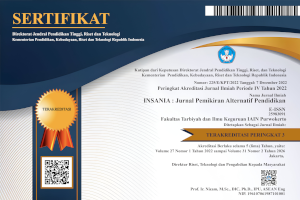DIMENSI KECERDASAN MAJEMUK DALAM KURIKULUM 2013
DOI:
https://doi.org/10.24090/insania.v19i1.462Keywords:
2013 Curriculum, Multiple Intelligences, Scientific, l AuthenticAbstract
This paper aims to reveal the relevance of changing and developing of 2013 curriculum with nine intelligences theory (multiple intelligences) developed by Howard Gardner. The results show that 2013 curriculum contains the development dimension of multiple intelligences that can be seen in three areas, the first is the development of competencies which consists of four competency cores; those are spiritual attitude, social attitudes, knowledge and skills. In agrove of multiple intelligences, they belong to several kinds of intelligences such as the dimensions of existential, interpersonal, intrapersonal, linguistic, logical-mathematical, musical, visual/spatial, bodily-kinesthetic, and naturalist/environment intelligence. The second is in the approach used in the form of a scientific approach, including; observing, asking, trying, reasoning, and communicating. The third is the scoring system done by authentic assessment.Downloads
References
Amstrong, Thomas. & Chatib Munif. 2011. Sekolah Para Juara: Menerapkan Multiple Intelegence di Dunia Pendidikan. Bandung: Kaifa.
Anonim. Multiple Intelligences: New Horizons. dalam http://www.
howardgardner.com/books/books.html, diakses 26 April 2014.
Azwar, Saifuddin. 1996. Pengantar Psikologi Intelligensi. Yogyakarta: Pustaka Pelajar.
Baharuddin dan Wahyuni Nur. 2007. Teori Belajar dan Pembelajaran. Yogyakarta: Ar- Ruzz Media.
Departemen Pendidikan dan Kebudayaan. 2003. Undang Undang Republik Indonesia Nomor 20 tahun 2003 tentang Sistem Pendidikan Nasional. Jakarta: Pusat data dan Informasi Pendidikan, Balitbang Depdiknas.
Direktorat Jenderal Pendidikan Islam. 2013. Direktorat Pendidikan Agama Islam, Pedoman Umum Implementasi Kurikulum 2013, Jakarta: Kementerian Agama RI.
Doll, Ronald C. 1996. Curriculum Improvemet Decision Making And Process. Boston: Nallyn Bacon.
Efendi, Agus. 2005. Revolusi Kecerdasan Abad 21: Kritik MI, El, SQ, AQ, dan Successsful Intelegence atas IQ. Bandung: Alfabeta.
Gardner, Howard. 1983. Frames of Mind: The Theory of Multiple Intelegences. New York: Basic Book.
Gardner, Howard. Intelligence Reframed: Multiple Intelligences for the 21st Century,†dalam http://pzweb.harvard.edu/ebookstore/detail.cfm?pub id=S6, diakses pada 26 April 2014.
Good, Carter V. (ed). 1973. Dictionary of Education, Third edition. New York: McGraw-Hill.
Hidayat, Sholeh. 2013. Pengembangan Kurikulum Baru. Bandung: Rosda.
Idi, Abdullah. 2007. Pengembangan Kurikulum Teori Dan Praktek. Yogyakarta: Ar-Ruzz Media.
Instruksi Menteri Pendidikan Dasar dan Kebudayaan Nomor 2 (Panca Wardhana/ Hari Krida) Tahun 1961
Kunandar. 2007. Implementasi Kurikulum KTSP. Jakarta: PT Raja Grafindo Persada.
Nasution, S. 2003. Pengembangan Kurikulum. Bandung: PT Citra
Aditya Bakti. Oliva, Peter F. 1992. Developing the Curriculum. New York: HarperCollins Publisher.
Paul, Supamo. 2007. Teori Perkembangan Kognitif Jean Piaget. Yogyakarta: Kanisius.
Paul,Supamo. 2008.Teori Intelligensi Ganda dan Aplikasinya di Sekolah: Cara Menerapkan Teori Multiple Intelegences Howard Gardner.Yogyakarta: Kanisius.
Peraturan Menteri Pendidikan dan Kebudayaan Republik Indonesia Nomor 54 Tahun 2013 tentang Standar Kompetensi Lulusan Proses Pendidikan Dasar dan Menengah.
Peraturan Menteri Pendidikan dan Kebudayaan Republik Indonesia Nomor 64 Tahun 2013 tentang Standar Isi Pendidikan Dasar dan Menengah.
Peraturan Menteri Pendidikan dan Kebudayaan Republik Indonesia Nomor 65 Tahun 2013 tentang Standar Proses Pendidikan Dasar dan Menengah.
Peraturan Menteri Pendidikan dan Kebudayaan Republik Indonesia Nomor 67 Tahun 2013 tentang Kerangka Dasar dan Struktur Kurikulum Sekolah Dasar/ Madrasah Ibtidaiyah.
Peraturan Pemerintah Republik Indonesia Nomor 32 Tahun 2013 Tentang Perubahan Atas Peraturan Pemerintah Nomor 19 Tahun 2005 Tentang Standar Nasional Pendidikan.
Permendikbud 81A tentang Implementasi Kurikulum, 2013.
Raharjo, Rahmat. 2012. Pengembangan & Inovasi Kurikulum. Yogyakarta: Baituna Publishing.
Sanjaya, Wina. 2008. Kurikulum dan Pembelajaran. Jakarta: Kencana.
Soetopo, Hendyat dan Wasty Soemanto. 1986. Pembinaan dan Pengembangan Kurikulum. Jakarta: Bina Aksara.
Spencer, Lyle M. 1993. Competence at Work: Models for Superior Performance. Canada: John wiley & Son, Inc.
Tilaar, H.A.R. 1995. 50 Tahun Pembangunan Pendidikan Nasional 1945 – 1995. Jakarta: Grasindo.
Zohar, Danah. 2007. SQ: Kecerdasan Spiritual. (terj) Rahmani Astuti. Bandung: Mizan Pustaka.
Downloads
How to Cite
Issue
Section
License
Authors who publish with this journal agree to the following terms:
Authors retain copyright and grant the journal right of first publication with the work simultaneously licensed under a Creative CommonsAttribution-ShareAlike License that allows others to share the work with an acknowledgment of the work's authorship and initial publication in this journal.
Authors are able to enter into separate, additional contractual arrangements for the non-exclusive distribution of the journal's published version of the work (e.g., post it to an institutional repository or publish it in a book), with an acknowledgment of its initial publication in this journal.
Authors are permitted and encouraged to post their work online (e.g., in institutional repositories or on their website) prior to and during the submission process, as it can lead to productive exchanges, as well as earlier and greater citation of published work (See The Effect of Open Access).








